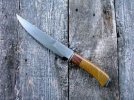I haven't cut any osage for knife handles yet, but I have made several bows using this wood. The trick to drying osage is controlling the moisture loss once the wood is cut. Here are some rule of thumb suggestions to keep the wood from craking/splitting/checking once you cut it:
1) If you cut a piece of wood off a living/green tree, seal the ends as quickly as possible (wood glue or paint will work just fine) because water will escape from the open/exposed grains faster than it will through the bark and cause the wood on the ends to check or crack as they dry faster than the rest of the log.
2) If you cut the wood green and remove the bark be sure and remove the sap wood (that the white stuff) since the sap wood loses moisture faster than the heart wood. So even if you seal the ends and remove the bark without removing the sap wood you will still get checking/cracking.
3) If you cut the wood green, seal the ends and take if back to the shop you can do several things to speed up the drying. You can split the wood and expose a large area of wood grain to drying/moisture release. If you leave the bark on one side after you split it you may see some warping due to the moisture escaping faster along the split side, this depends on how thick the piece is you split out. You can take the split piece and cut it into blanks say 2X2X6 inches (all heart wood, no bark or sapwood) and these should dry relatively quickly with out too much movement or warping. You could even put these pieces in front of a fan or in some controlled heated area (100 - 120F) and they would dry even quicker. Once the 2X2 piece sits a week or so, it can probably be cut into thinner strips without warping. If done in this fashion, the wood should be dry and stable within a month.
Basically the thinner the wood the sooner it will dry. By dry I mean come to equilibrium with the it's surroundings. Therefore wood in dried in this fashion along the coast would have a higher moisture content then the same wood dried in this fashion in the dessert.
One last thing, if you cut the wood and leave it outside to dry with the bark on there is a wasp that likes to lay it's eggs/larvae in the bark of the tree. This larvae then likes to eat the sapwood. Unfortunatly often times it eats down into the heartwood a ways before it turns and goes back into the sapwood. This may not be a problem for knife handle size wood, but it sure can ruin a bow makers day. Hopefully this helps.

